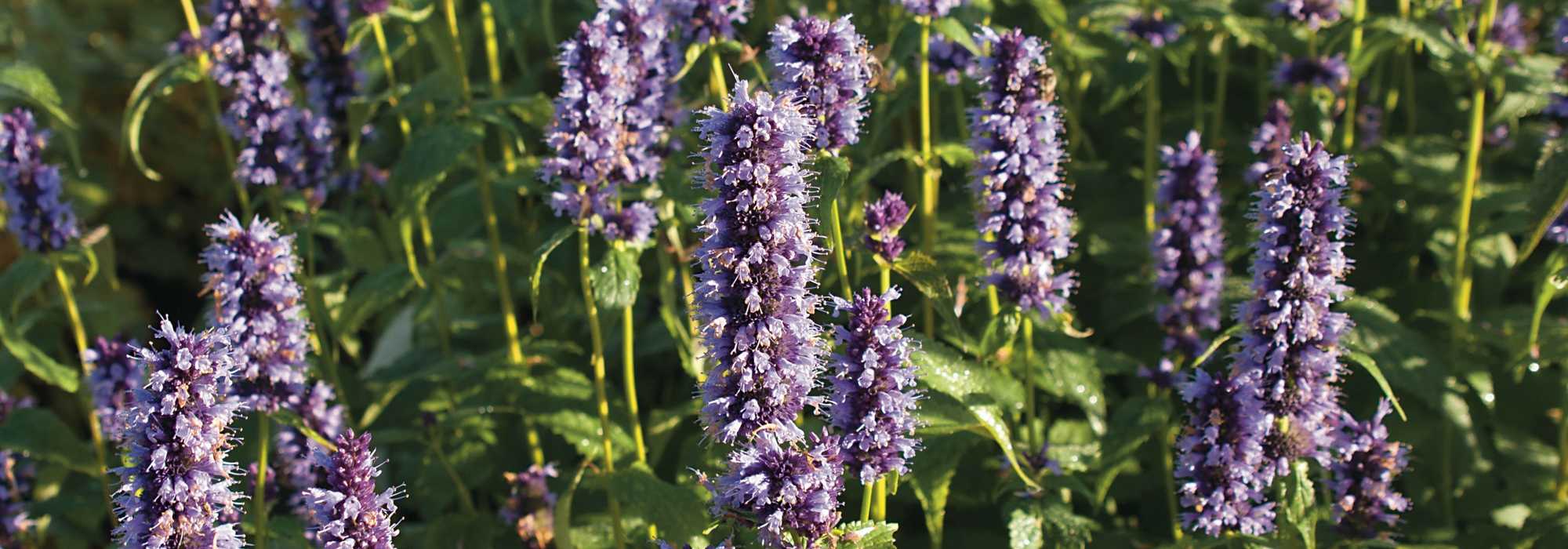
Agastache: to plant, to grow and to maintain
Contents
Agastache in a nutshell
- Agastache is a lovely perennial with summer flowering
- Its highly melliferous flowering is reminiscent of lavender
- Very aromatic, its foliage releases a sweet anise scent
- It is a low-maintenance and easy-going plant
- Its slightly wild appearance works wonders in natural gardens
A word from our expert
The agastache is a lovely perennial that resembles lavender, with its beautiful bushy habit and flowering spikes. Highly aromatic, the species Agastache foeniculum is appreciated both in the garden and in the kitchen. Its aniseed scent has earned it the nickname of anise hyssop. Agastache rugosa, or rough agastache, is also among the most well-known, with its minty fragrance. Its somewhat wild appearance is particularly wonderful in natural gardens.
Agastache comes in a wide variety of colours, allowing it to fit into any garden. From the soft lavender blue of the variety ‘Blue Fortune’ to the intense purplish-red of A. mexicana ‘Red Fortune’, this charming perennial adds a touch of whimsy to rockeries where its dense, upright habit shines. It also brightens summer borders, and its aromatic character is ideal for scenting edges. The variety ‘Golden Jubilee’, with its remarkable golden-yellow foliage, particularly lights up the garden. Natural and wild, agastache is also perfect for a flowering meadow or to dress up a rather dull bank.
Highly melliferous, the spikes of agastache attract numerous pollinating insects. A valuable ally in the vegetable garden and for the biodiversity of all our gardens, even urban ones!

The flowers of agastache are highly melliferous.
Quite hardy enough to thrive anywhere in France, agastache is an easy-care plant that will delight all gardeners, even beginners. There is only one true condition for its happiness: perfectly drained soil. It adapts to a wide range of soils, fearing only heavy, clayey lands that become waterlogged in winter. It withstands both drought and cold and is not troubled by pests or diseases. Even though powdery mildew may appear during the hottest, driest summers, it remains without harmful consequences.
Although agastache has a relatively short lifespan for a perennial (4-5 years), it makes up for this minor flaw with its numerous spontaneous seedlings, which constantly provide new shoots at its feet. Aromatic and vibrant, this long-overlooked perennial truly has all the qualities to be embraced in the garden!
Description and Botany
Botanical data
- Latin name Agastache
- Family Lamiaceae
- Common name Agastache
- Flowering Summer
- Height 0.30 to 1.50 m
- Exposure Sun, partial shade
- Soil type Rich, cool, perfectly drained
- Hardiness -15°C
The agastache is an aromatic perennial whose flowering resembles the spikes of lavender. It is, in fact, part of the same family: the Lamiaceae. The genus comprises about thirty species, originating from North America, Mexico, and also Asia (China and Japan), where it naturally thrives in dry environments.
Highly ornamental, agastache has a upright, dense, and bushy habit, varying from 45 cm in height for the smallest varieties (Kudos series) to over 1.50 m for Agastache foeniculum ‘Golden Jubilee’ or anise hyssop.
The highly aromatic foliage exudes, depending on the variety, a fragrance with notes of anise, liquorice, mint, or lemon that is much appreciated in cooking, for flavouring dishes or in infusions. The deciduous leaves are simple, lanceolate, more or less triangular in shape, with finely dentate edges. Fuzzy on the underside, they display a hue ranging from medium green to deep green, not forgetting the bright ‘Golden Jubilee’ with its golden foliage.
From this compact tuft emerge upright spikes, made up of a multitude of small flowers in shades of mauve, violet, pink, orange, red, or even white, depending on the variety. This flowering, as vibrant as it is melliferous, attracts numerous pollinators, making it a valuable ally for biodiversity in our gardens. An advantage you can particularly benefit from by planting a few feet in the vegetable garden.

Agastache comes in a beautiful range of colours: Agastache ‘Black Adder’ / Agastache ‘Kudos Gold’ / Agastache rugosa ‘Alabaster’ / Agastache ‘Kudos Coral’ / Agastache ‘Summer Sunset’.
More or less hardy, some species are sometimes grown as annuals, particularly Agastache foeniculum. They are especially sensitive to heavy soils that retain water in winter. However, these perennials adapt to all our climates, provided the soil is perfectly drained. Preferably, use a dry soil, even poor or calcareous. Agastache, for example, thrives very well in rockeries. In clay soil, favour the planting of Agastache rugosa, which is more tolerant.

Different foliage: Agastache ‘Golden Jubilee’ / Agastache ‘After Eight’ / Agastache mexicana ‘Red Fortune’ / Agastache rupestris / Agastache nepetoides.
In any case, and even though agastache tolerates partial shade, install it preferably in full sun, where it will develop all its aromatic qualities and a more abundant flowering. It will look wonderful in borders or rockeries alongside other dry-land plants. You can also enjoy its wild appearance in a flowering meadow or on a well-drained slope. And if you don’t have a garden, agastache will also find its place in a pot to enhance a well-exposed balcony!
Agastache is a perennial with a relatively short lifespan, between 4 and 5 years. However, it continuously renews itself through spontaneous sowing and divides very easily.
Discover agastaches in video:
Species and varieties
Agastache foeniculum, or anise hyssop, is one of the best-known species of the genus. Its cultivar ‘Golden Jubilee’ is particularly appreciated for its golden foliage.
Agastache rugosa also stands out for its greater tolerance to heavy soils and its wild appearance, which works wonders in a natural garden.
Other species can be distinguished, but you will generally find hybrid varieties in commerce, whose origins are not always specified. Whatever your choice, remember to plant your agastaches in well-drained soil so they can fully thrive.
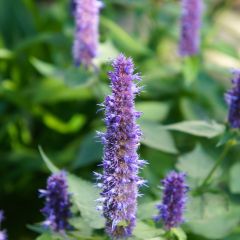
Agastache foeniculum Blackadder
- Flowering time July to October
- Height at maturity 80 cm
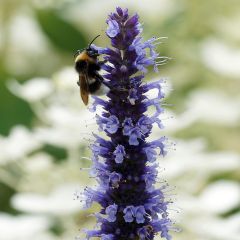
Agastache x rugosa Blue Fortune
- Flowering time August to October
- Height at maturity 80 cm
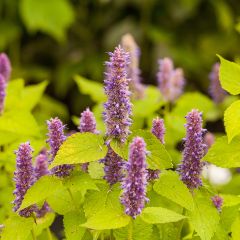
Agastache foeniculum Golden Jubilee
- Flowering time August to October
- Height at maturity 1,20 m
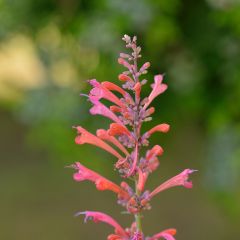
Agastache Kudos Coral
- Flowering time July to October
- Height at maturity 45 cm

Agastache mexicana Red Fortune
- Flowering time July to November
- Height at maturity 1,20 m
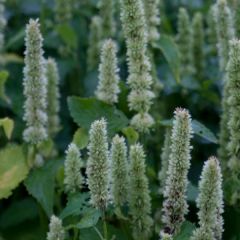
Agastache rugosa Alabaster
- Flowering time July to October
- Height at maturity 80 cm
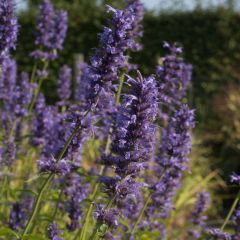
Agastache Serpentine
- Flowering time August to October
- Height at maturity 1,50 m
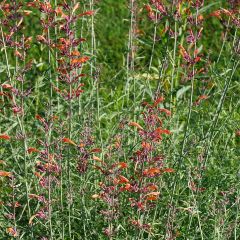
Agastache rupestris
- Flowering time August to October
- Height at maturity 60 cm
Discover other Agastache
View all →Available in 1 sizes
Available in 1 sizes
Available in 1 sizes
Available in 1 sizes
Available in 1 sizes
Available in 2 sizes
Available in 2 sizes
Available in 1 sizes
Available in 2 sizes
Available in 1 sizes
Planting Agastache
Where to plant it?
Hardy down to about -15°C and drought-resistant, agastache is a low-maintenance plant that thrives in all our climates.
It particularly enjoys rich and cool soils, but can flourish in any ordinary soil, even poor or calcareous. In heavy, wet soil, we recommend Agastache rugosa, which adapts better to clay soils. The soil pH is rather indifferent to it, with a preference for neutral to calcareous soils.
Whatever your soil type, it must be well-drained. While agastache can withstand drought, at the expense of a beautiful flowering, it hates waterlogged soils. Excess moisture can even be fatal in winter.
Preferably choose a well-sunny location to fully enjoy its aromatic character and abundant flowering. However, it can tolerate partial shade. In any case, protect it from cold winds by placing it against a well-exposed wall, for example.
Agastache can also be grown in pots to enhance a terrace or large balcony.
When to plant agastache?
Plant agastache in spring, from March to May, when the risk of frost has passed. Planting in warm soil in autumn, between September and November, is also possible.
How to plant it?
In open ground:
- Prepare the soil by loosening it deeply.
- Add well-decomposed compost, which will have the dual advantage of enriching the soil while improving its drainage.
- Dig a planting hole at least 3 times the size of the root ball.
- Place a layer of coarse gravel at the bottom of the planting hole to facilitate drainage. Do not use fine sand, as it will have the opposite effect!
- Install the young plant, ensuring not to bury the collar (the junction point between the root system and the stem).
- Backfill, compacting the soil around the base.
- Water immediately.
Maintain a density of 5 to 6 plants per m². Be cautious with larger varieties, such as agastache ‘Serpentine’, which can reach 90 cm in width at ripeness.
In pots:
- Choose a terracotta container with drainage holes at the bottom to ensure good drainage.
- Place a layer of gravel or clay balls at the bottom of the pot, again to promote drainage.
- Plant your young plant in a mixture of garden soil and well-decomposed compost.
→ Learn more about How to grow Agastache in pots in Christine’s article.
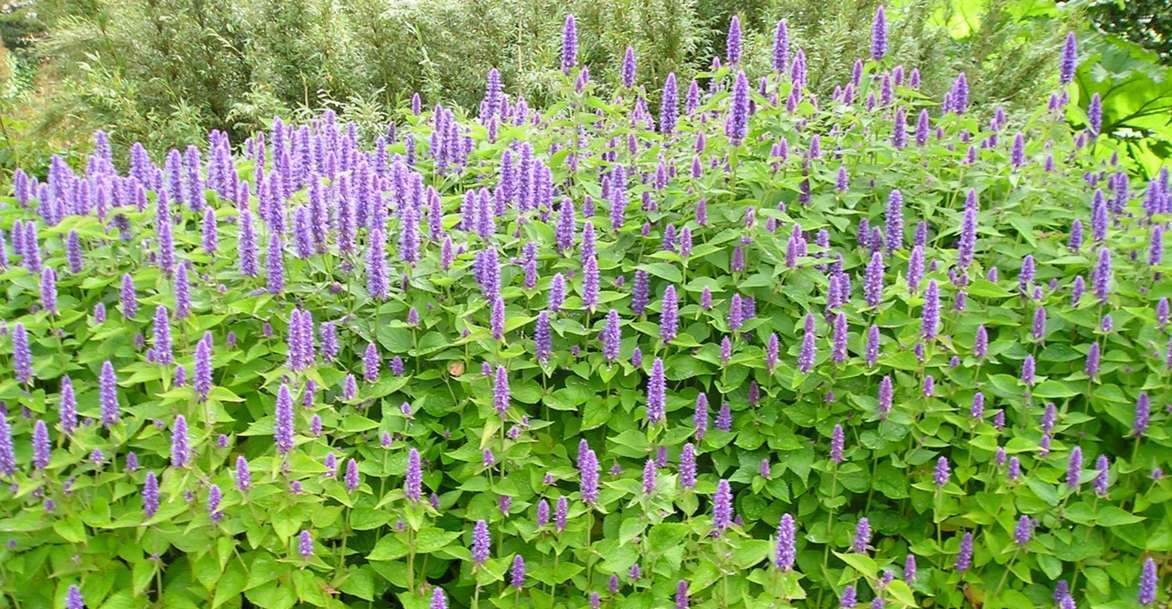
Agastache foeniculum planted in mass.
Read also
How to sow Agastache?Maintenance
Agastache is a very easy-going plant. In good growing conditions, such as very well-drained soil, it can even thrive with minimal maintenance.
During spring (May-June), do not hesitate to pinch back the taller varieties to encourage branching. Cut the tips of the stems by a few centimetres when they reach 15 to 25 cm in height. This pruning helps achieve a denser habit and a more abundant flowering.
You can cut the faded spikes as they appear to stimulate the emergence of new flowers. If you wish to collect seeds or allow your agastaches to self-seed, leave a few spikes in place.
Agastache is quite drought-resistant, although regular watering is beneficial for its flowering. However, in pots, be sure to water regularly to prevent the medium from drying out. Be cautious of stagnant water in the saucers, as it can be harmful.
Even when dry, the inflorescences of agastache remain very decorative. When autumn arrives, you can leave them in place and enjoy a rustic decor. Keeping the aerial parts during winter also helps better protect the stumps from frost. Wait until early spring to cut the dry spikes and tidy up the clump.
If the winter aesthetics of agastache does not inspire you, an autumn pruning is possible. You can take the opportunity to incorporate some spikes into a dried bouquet. However, be sure to mark the location of your plants in case of severe cutting (pruning to about 5 cm above the ground). Winter passes, the memory of agastache fades, and with the return of spring, we find ourselves digging in the middle of the clump!
Potted plants, more exposed to frost, can be wintered in a sheltered spot, such as an unheated conservatory.
Agastache is a vigorous perennial that is resistant to both diseases and pests. Powdery mildew can affect its foliage during hot, dry summers, but it is not serious. Simply cut away the affected parts.
Like all tender young shoots, those of agastache can be coveted by slugs in spring. There is no need for treatment; just monitor until the plants develop and no longer attract gastropods. In case of a true invasion, use a product like Ferramol, which is accepted in organic farming.
Multiplying Agastache: Sowing, Division and Propagation by Cuttings
Agastache is a perennial with a relatively short lifespan (4-5 years on average) but it self-renews through spontaneous sowing. It is also possible to harvest its seeds for sowing in a sheltered environment, or to propagate it by division of the stump or propagation by cuttings of semi-woody stems.
Sowing
Agastache seeds are easily harvested from the dried spikes. Store them dry and away from light during winter.
Sowing is done from February to April in a heated shelter. The seeds germinate within a few weeks, at a temperature between 15 and 20°C.
- Sow finely in trays using a special seed compost.
- Lightly cover the seeds with well-decomposed compost or vermiculite.
- Cover the tray with its transparent lid or with a transparent plastic bag for 30 to 90 days (germination time).
- Place the tray in light and keep the substrate moist.
- Transplant into individual buckets when the plants are between 5 and 10 cm tall.
- Place the buckets under a cold frame.
- Once the risk of frost has passed, plant the young plants in their final location.

Sowing of Agastache foeniculum.
Be aware that if you are growing several species of agastaches, the results of the sowing can be surprising. Different species easily hybridise with each other, and the characteristics of the new plants may differ from the original plant.
→ Also check out Christine’s tutorial: How to sow Agastache?
Division
Agastache is well-suited to stump division in spring, between March and April:
- Dig up the clump using a sharp spade.
- Divide it into several pieces, again using your spade.
- Replant immediately and water thoroughly.
Wait at least 2 years before performing another division on the new clumps obtained.
Propagation by Cuttings
Propagation by cuttings of agastache is done on semi-woody stems (still flexible) in August:
- Choose stems from the current year that have not flowered.
- Cut the ends to obtain cuttings of 15 to 20 cm.
- Remove the leaves, keeping only those at the top.
- Plant the cuttings in compost mixed with compost or vermiculite.
- Moisten the substrate.
- Keep the cutting outside all winter, protected from frost and sunlight, while regularly moistening.
- Transplant in spring, once the risk of frost has passed.
→ Also check out Christine’s tutorial: How to take cuttings from Agastache?
Associating Agastache in the garden
The slightly wild appearance of agastache is ideal for a natural garden to create beautiful rockeries. The Sedum is an excellent companion, perfectly suited to dry soils. Choose the white variety to highlight the colour of your agastache spikes.
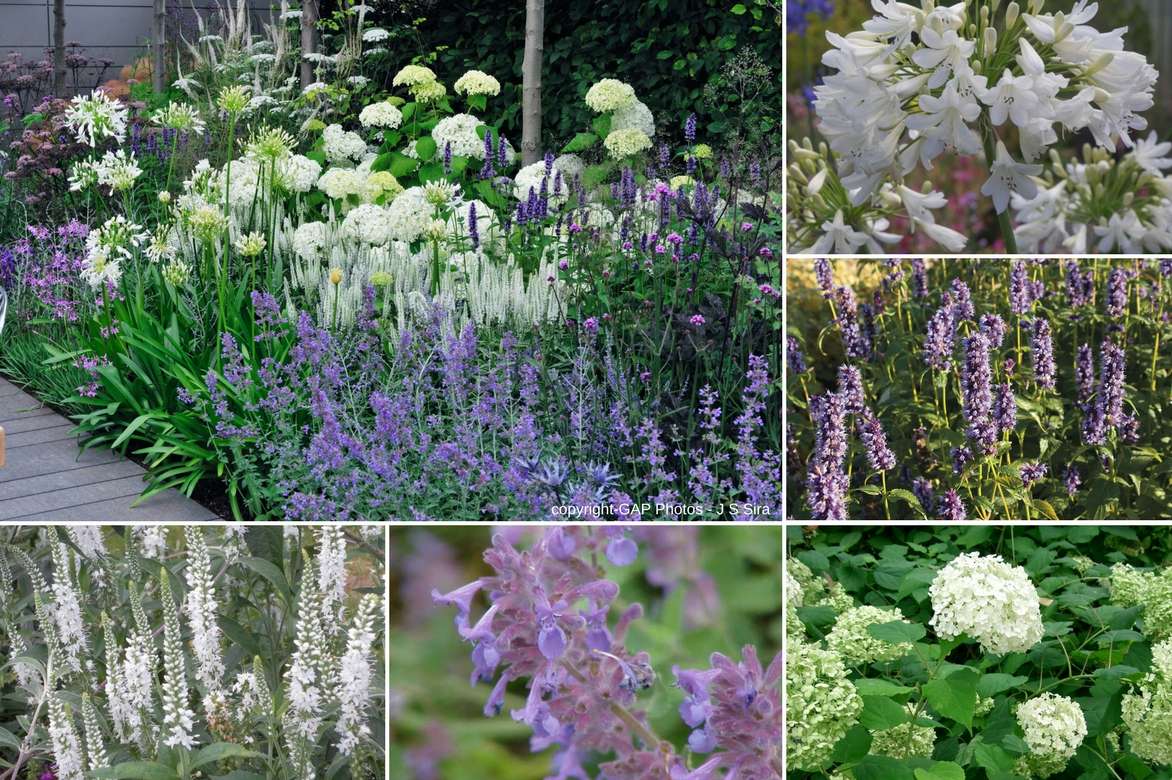
A blue and white combination idea: Agapanthus ‘Polar Ice’ / Agastache ‘Black Adder’ / Hydrangea arborescens ‘Annabelle’ / Nepeta mussinii / Veronica spicata ‘Alba’.
In a flowerbed, alternate agastaches with other country-style plants such as cosmos, rudbeckias, or small grasses like blue oat (Helictotrichon sempervirens). Maintain a planting distance of about 80 cm between each young plant to allow them to fully flourish.
Agastache is also perfect for creating a border, for example along a south-facing wall. It will also be sheltered from cold winds. Pair the purplish pink of agastache Kudos ‘Silver Blue’ with the graphic steel blue balls of Echinops ritro and the soft pink of Phlox paniculata ‘Rosa Pastel’. Place a Stachys byzantina ‘Big Ears’ in the foreground, where its fuzzy grey foliage will beautifully enhance the colours of your composition.
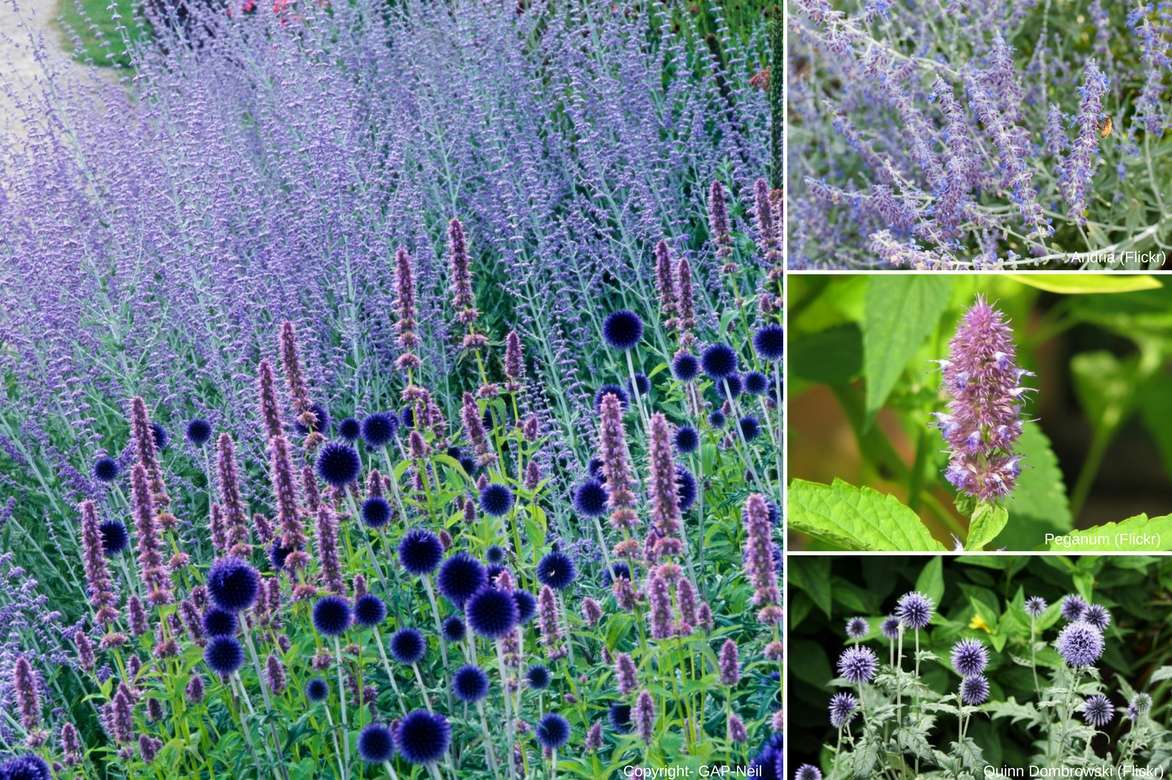
A beautiful combination idea: Echinops ritro ‘Veitch’s Blue’ / Agastache rugosa ‘Golden Jubilee’ / Perovskia atriplicifolia ‘Blue Spire‘.
For a more vibrant scene, use warm colours that will elegantly contrast with the lavender blue spikes of agastache ‘Serpentine’. Heliopsis, helianthes, or rudbeckias are all good candidates for this purpose. Also add height to your composition with the tall umbels of agapanthus, reaching up to 1 m in height.
Agastache is perfect in a flowering meadow or in a border when paired with nepeta or gauras. Stipas will add an even more rustic and wild touch to this floral decor.
The most compact varieties, particularly those from the Kudos series that barely exceed 45 cm in height, can be grown in pots or containers to brighten up a sunny balcony. They will look wonderful alone or accompanied by trailing plants, such as petunias or ivy geraniums.
On a terrace, dare to use taller varieties that will form a beautiful clump and pleasantly enhance the space. Ensure you have a terracotta pot that is wide enough (30 to 50 cm in diameter minimum) for your agastache to fully thrive.
Need a little extra inspiration? Discover our article: Agastaches: 7 successful combination ideas!
Did you know?
The name agastache comes from the Greek “aga,” meaning abundance, and “stachys,” spike.
Useful resources
- Fall for one of our Agastache varieties!
- Learn more about edible plants and leaves that can be cooked
Frequently asked questions
-
My agastache plants did not come back this spring, why is that and what should I do?
The main enemy of agastache is overly wet soil in winter. Consider adding a layer of gravel when planting to improve drainage. In winter, do not cut back the withered aerial parts, as they help protect the stump from frost. Do not mulch, or regularly aerate your mulch during dry weather. A waterlogged mulch would be detrimental to your agastache.
-
I sowed agastache seeds directly in the ground in spring, but none have germinated. Can you help me?
Slugs, eager for young shoots, and poor climate conditions (heavy rains, late cold) make sowing directly in the ground tricky. Instead, try sowing in trays and under cover. Seeds germinate better at a temperature close to 20°C. Wait for the young plants to develop and pot them in buckets to strengthen them. Plant them permanently once they are strong and vigorous, in warm, well-drained soil.
- Subscribe!
- Contents
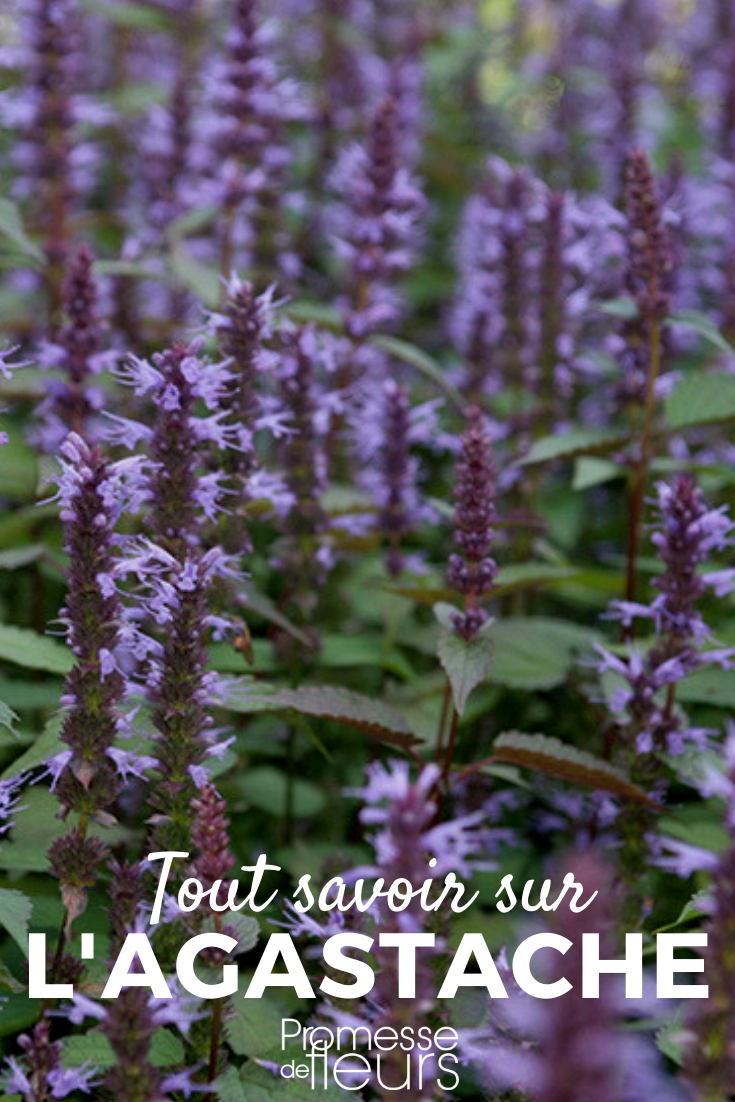































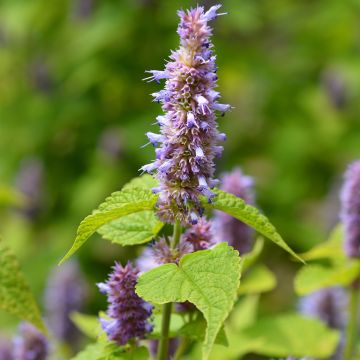
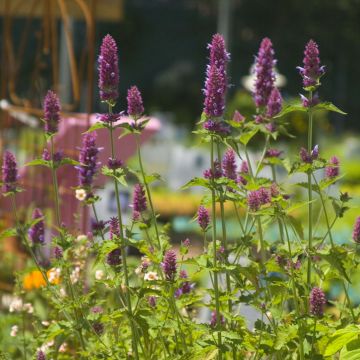
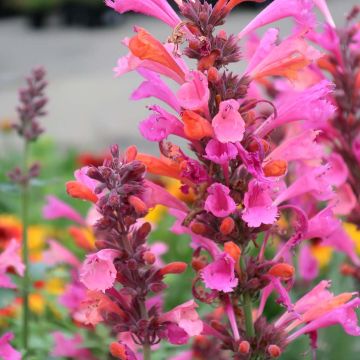
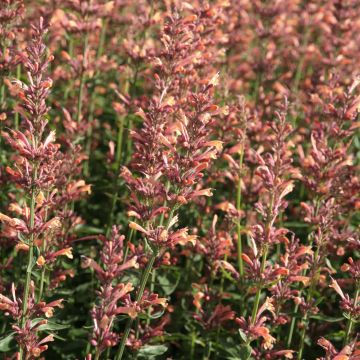


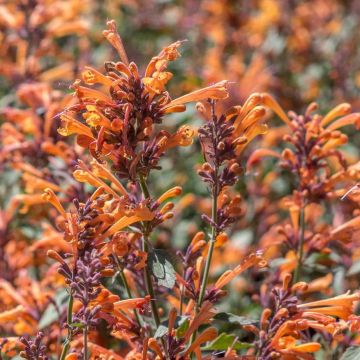
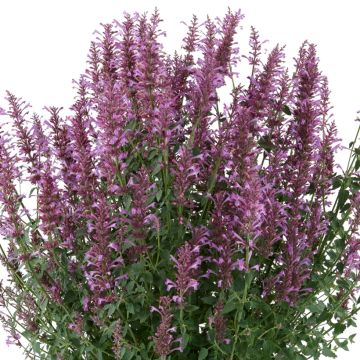
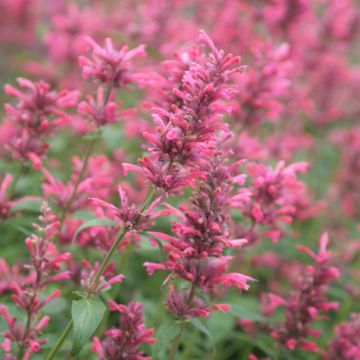

Comments